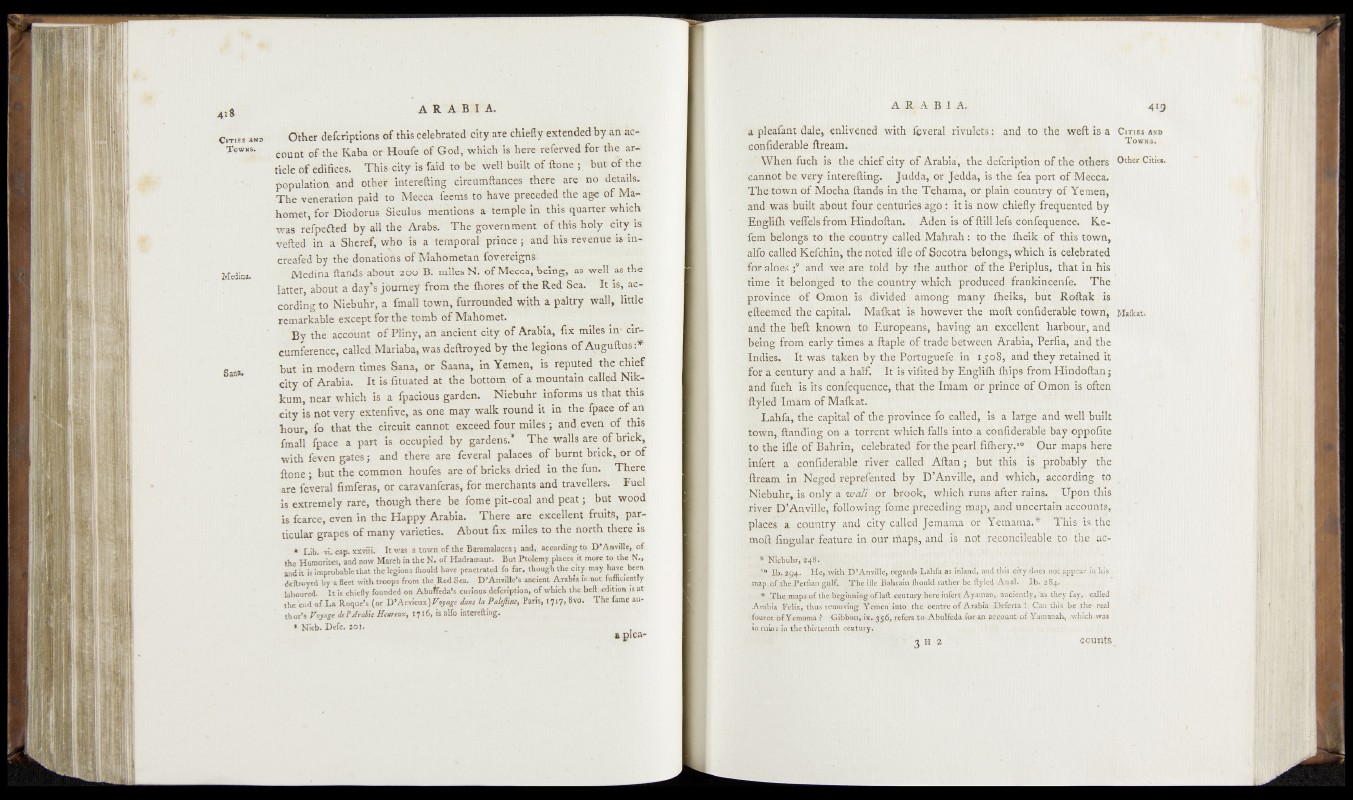
■
O ties awd
T owns.
Sana»
Other dfefcriptions of this celebrated city are chiefly extended by ân ac-
count of the Kaba or Houfe of God, which is here referved for the- article
of édifiées» This-eky is laid to be well built of tone 5. but* o f the
popuïàtioA'ând other interefting circnmftances there are no details.
The veneration paid to Mecca Teems to have pr^ed^d thé age.Of Ma^
hornet, for Diodorus Siculus mentions a temple in this quarter which
was refpeCted by all the Arabs. The government of- this holy' city- is
véftéd in a Sheref, who is a temporal prince 5 and Ms revenue is- inJ
creafed by the donations of Mahometan fevereigns:
' Medina Hands <about 2Ô0 B. miles N. of Mecca,being, as welfas the
hrtter, about a day’s journey ftom the flioïés of the Red Sea. It is * according
to Niebuhr, a fmafl towh, fmrounded with a paltry wall, little
remarkable except for the totnb of Mahomet.
Bv the account of FRny, aft ancient city, of Arabia, fix miles im C ircumference,
calledMariaba,was deftroyed by the legions c£A^guftus :*
but in modem times Sana, or Saana, in Yemen, ‘is reputei the'chief
city of Arabia. It isfituated at the bottom of a mountain called Nik-
kum, near which is a fpacious garden. Niebuhr informs us that this
city is not very extenfive, as one. may walk round it, in the fpace of an
hour, fo that the circuit cannot exceed four miles ; and,even, of this
fmall fpacé a part is. occupied by gardens.* The wall's are of brick,
with feven gates ; and there are feveral palaces qf burnt brick, or of
ftone ; but the common houles are of bricky dried » the fun. There
are feveral fimferas, or caravanferas, for merchants and travellefs. Fuel
is extremely rare, though there he fomé pit-coal and peat •/ „but wood
is fcarce, even in the Happy Arabia. There are excellent fruits, particular
grapes of many varieties. About fix miles to. the north there is
* Lib.- vi. cap. xxviii. It was a town of the Baramalaccs $ and, according tfe D ’Anville, of
the Homorites, and now March in the N. of Hadramaut. But Ptolemy .places it more to the N.,
andit is improbable that the legions ihould have penetrated fo far, though the city may have been
deftroyed by a fleet with troops from the Red Sea. D’Anville’s ancient Arabia is-.not fuffioiently
laboured. I t is chiefly founded on Abuffeda’s cnrious.defcription, of which the beft .edition is at
the end of La Roque’s (or D’Arvieux) Voyage dans la PaleJline, Pans, 1717, 8vo. The fame author’s
Voyage del’ Jralie Heureux, 1716, is alfo interefting.
» Nieb. Defc. 201, a pleaa
pleafant dal©,, enlivened with feveral rivulet,sand to the weft is a Cities as»
confiderable ftream. ' Towns.
' When fuch js the chief oity ©f Arabia',, the. defeription of the others Otter Cities,
cannot be very interefting., Judoa, or Jedda, is the fea port of Mecca.
The town of M©eha ftands ip the Tehama, or plain country of'Yemen,
and was built about four cetituri'eslago^ it is now .chiefly frequented by
F.ngiifti veffels from TIiadoftan. \ Aden is of ftill lefs confequenee» Ke-
Tfcm belongs to the xptmtiy called Mahrah : to the iheik o f Phis town,
alfo called "Kefchin^ the noted ifle o f Socotra belongs', which is celebrated
for-alofes '-f and'’we' are'toldi by the author o f the Periplus, that in his
time ft hel&n^ed- to the country which produced frankincenfe. The
province of ‘Cfeion is divided ambng Jnany lheiks, but Roftak is
efteemed the* capital. Mafkat is however the moll confiSerable'town, Maikat.
and the beft known t o ’European's, having an.j^eljqnt harbour, ana
being- from early times a ftaple o f trade fietweep'Arabia, Perfia, and the
Indigs. It was taken by the*Portuguefe*'in 1500/ and'they retained it
for* Century and a half. Tt is'vifited by Fnglilh ftlips froiri*Hindpftan;
and m ih ' i§ its cgnfequence, that the Imam or prince o f Omon is often
‘ftyiedTmam Of'Ma&at.^4"
Lahfa, the capital of the province To 'callefl,,^is a large and well built
town, Handing.on a torrent which falls into a confiderabie bay qppbfite
to the ifle of Bahrin, .celebrated for the pearl filhei-y,10 Gut jixapshefe
infejpt a GonfiqeEkhle river .called Aftan;• -but tnis is" probably the
ftream ia>N$ged r-eprefented by D’Anville, and wjhicb»:ric<tordiog to |
Niebuhr, is.-only a •wait or brook, which r^yi? after tains, ppen this
jiyer D’Anville, following’fp.rae preceding map, and uncertain'a.ccqunts, *
places a country and,fifty-called Jemaraa or Yemama.*' This is-the
m oft, lingular-feature in our rilaps, apd. as not YQcpnnjeJiljle, tto the ac-
5' YTiebuhri 2484
lb. 294. He,, with D’Anyille, .regards Lahfa as injkn'4,'. and tin's city does nqt.app.ear.in his
map of the Periian gulf. The ifle Bahrain Ihould .rather Ik: fliyled -A.ual. Ib. 284.
. * The.maps of.theibfginning of laft.eentury here inl'eri Ayaman,. anciently, "as they fay, called
Arabia Felix, thus removing Yemeni-infco the centre of Arabia Hefsrta !, Can this be the real
ifourc.e.pf Yemama ? Gibbon, ix. 356, refers’to^ Abulfeda for;an account of Yamanah, -which *was
in ruins in the,thirteenth century. ■
3 ft 2 counts